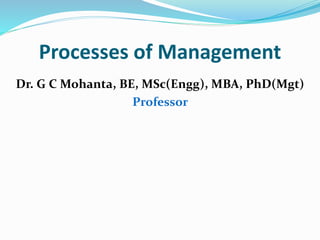
Processes of management
- 1. Processes of Management Dr. G C Mohanta, BE, MSc(Engg), MBA, PhD(Mgt) Professor
- 2. Management Process Some regard management process as getting things done through people; Some consider it as the process of reaching organizational goals by working with and through people.
- 3. Management Process (Contd.) Management process is defined as the process, composed of interrelated social and technical functions and activities (including roles), occurring in a formal organizational setting for the purpose of accomplishing predetermined objectives through the utilization of human and other resources. 3
- 4. Management Process (Contd.) According to D. E. McFarland, "Management process is the distinct process by which the managers create, direct, maintain and operate purposive organisation through systematic, co-coordinated and cooperative human efforts”. According to Gemp R. Terry, "Management process is a distinct process consisting of planning, organising, actuating and controlling, performed to determine and accomplish objectives by the use of people and other resources".
- 5. Elements/Components of Management Process The essential elements/components of Management Process are four which are actually basic functions of management: Planning Organising Directing and Controlling. We may add some more elements in the management process as follows: Motivating Co-coordinating Staffing and Communicating.
- 6. Elements/Components of Management Process (Contd.) Luther Gullic gave a new formula to suggest the elements of Management Process i.e. basic functions of management. According to him, management process may be indicated by the word "PODSCORB”. Here, ‘P' states for 'planning'. "O" for 'organising', "D" for 'directing', "S" for 'Staffing', "CO" for 'Coordinating, "R" for 'Reporting' and "B" for 'Budgeting'. Gullic coined the word "PODSCORB" to suggest seven functions of management.
- 8. Planning Planning is the primary function of management. It involves determination of a course of action to achieve desired results/objectives. Planning is the starting point of management process and all other functions of management are related to and dependent on planning function. Planning is the key to success, stability and prosperity in business. It acts as a tool for solving the problems of a business unit. It helps to visualize the future problems and keeps management ready with possible solutions.
- 9. Organising Organising means bringing the resources (men, materials, machines, etc.) together and use them properly for achieving the objectives. Organisation is a process as well as it is a structure. Organising means arranging ways and means for the execution of a business plan. It provides suitable administrative structure and facilitates execution of proposed plan. Organising involves departmentalisation, establishing span of control, delegation of authority, establishment of superior-subordinate relationship and provision of mechanism for co-ordination of various business activities.
- 10. Staffing Staffing refers to provision of manpower for the execution of a business plan. Staffing involves recruitment, selection, appraisal, remuneration and development of personnel. The need of staffing arises in the initial period and also from time to time for replacement and also along with the expansion and diversification of business activities. Every business unit needs efficient, stable and cooperative staff for the management of business activities. Manpower is the most important asset of a business unit. In many organisations, manpower planning and development activities are entrusted to personnel manager or HRD manager. 'Right man for the right job' is the basic principle in staffing.
- 11. Directing (Leading) Directing deals with guiding and instructing people to do the work in the right manner. Directing is the responsibility of managers at all levels. They have to work as leaders of their subordinates. Clear plans and sound organisation set the stage but it requires a manager to direct and lead his men for achieving the objectives. It involves raising the morale of subordinates. It also involves communicating, leading and motivating. Leadership is essential on the part of managers for achieving organisational objectives.
- 12. Coordinating Effective coordination and also integration of activities of different departments are essential for orderly working of an Organisation. A manager must coordinate the work for which he is accountable. Coordination is essential at all levels of management. It gives one clear-cut direction to the activities of individuals and departments. It also avoids misdirection and wastages and brings unity of action in the Organisation.
- 13. Controlling Controlling involves three broad aspects: (a) establishing standards of performance, (b) measuring work in progress and interpreting results achieved, and (c) taking corrective actions, if required. Managers have to exercise effective control in order to bring success to a business plan. Controlling is a continuous activity of a supervisory nature.
- 14. Motivating Motivating is the process through which a manager motivates his men to give their best to the Organisation. It means to encourage people to take more interest and initiative in the work assigned. Organisations prosper when the employees are motivated through special efforts including provision of facilities and incentives. Motivation is actually inspiring and encouraging people to work more and contribute more to achieve organisational objectives. It is a psychological process of great significance.
- 15. Communicating Communication is necessary for the exchange of facts, opinions, ideas and information between individual and departments. In an organisation, communication is useful for giving information, guidance and instructions. Managers should be good communicators. They have to use major portion of their time on communication in order to direct, motivate and co-ordinate activities of their subordinates. People think and act collectively through communication. According to Louis Allen, "Communication involves a systematic and continuing process of telling, listening and understanding".
